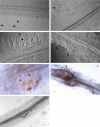Effects of phosphorus and nitrogen on nodulation are seen already at the stage of early cortical cell divisions in Alnus incana
- PMID: 16735402
- PMCID: PMC2803461
- DOI: 10.1093/aob/mcl109
Effects of phosphorus and nitrogen on nodulation are seen already at the stage of early cortical cell divisions in Alnus incana
Abstract
Background and aims: The present work aimed to study early stages of nodulation in a chronological sequence and to study phosphorus and nitrogen effects on early stages of nodulation in Alnus incana infected by Frankia. A method was developed to quantify early nodulation stages in intact root systems in the root hair-infected actinorhizal plant A. incana. Plant tissue responses were followed every 2 d until 14 d after inoculation. Cortical cell divisions were already seen 2 d after inoculation with Frankia. Cortical cell division areas, prenodules, nodule primordia and emerging nodules were quantified as host responses to infection.
Methods: Seedlings were grown in pouches and received different levels of phosphorus and nitrogen. Four levels of phosphorus (from 0.03 to 1 mM P) and two levels of nitrogen (0.71 and 6.45 mM N) were used to study P and N effects on these early stages of nodule development.
Key results: P at a medium concentration (0.1 mM) stimulated cell divisions in the cortex and a number of prenodules, nodule primordia and emerging nodules as compared with higher or lower P levels. A high N level inhibited early cell divisions in the cortex, and this was particularly evident when the length of cell division areas and presence of the nodulation stages were related to root length.
Conclusions: Extended cortical cell division areas were found that have not been previously shown in A. incana. The results show that effects of P and N are already expressed at the stage when the first cortical cell divisions are induced by Frankia.
Figures







Similar articles
-
Regulation of nodulation in the absence of N2 is different in actinorhizal plants with different infection pathways.J Exp Bot. 2003 Apr;54(385):1253-8. doi: 10.1093/jxb/erg131. J Exp Bot. 2003. PMID: 12654876
-
Local and systemic effects of phosphorus and nitrogen on nodulation and nodule function in Alnus incana.J Exp Bot. 2003 Dec;54(393):2757-67. doi: 10.1093/jxb/erg311. Epub 2003 Oct 29. J Exp Bot. 2003. PMID: 14585829
-
Molecular diversity of Frankia in root nodules of Alnus incana grown with inoculum from polluted urban soils.FEMS Microbiol Ecol. 2004 Nov 1;50(3):255-63. doi: 10.1016/j.femsec.2004.07.002. FEMS Microbiol Ecol. 2004. PMID: 19712365
-
Symbiosis between Frankia and actinorhizal plants: root nodules of non-legumes.Indian J Exp Biol. 2003 Oct;41(10):1165-83. Indian J Exp Biol. 2003. PMID: 15242283 Review.
-
Actinorhizal symbioses and their N2 fixation.New Phytol. 1997 Jul;136(3):375-405. doi: 10.1046/j.1469-8137.1997.00755.x. New Phytol. 1997. PMID: 33863007 Review.
Cited by
-
Bacterial Metabolic Potential in Response to Climate Warming Alters the Decomposition Process of Aquatic Plant Litter-In Shallow Lake Mesocosms.Microorganisms. 2022 Jun 30;10(7):1327. doi: 10.3390/microorganisms10071327. Microorganisms. 2022. PMID: 35889044 Free PMC article.
-
Hippophae rhamnoides L. rhizobacteria exhibit diversified cellulase and pectinase activities.Physiol Mol Biol Plants. 2020 May;26(5):1075-1085. doi: 10.1007/s12298-020-00778-2. Epub 2020 Mar 19. Physiol Mol Biol Plants. 2020. PMID: 32377055 Free PMC article.
-
Nondestructive Detection of Frankia in Alnus glutinosa With NIR Spectroscopy.Plant Environ Interact. 2025 Jul 4;6(4):e70066. doi: 10.1002/pei3.70066. eCollection 2025 Aug. Plant Environ Interact. 2025. PMID: 40625865 Free PMC article.
-
Ancient CO2 levels favor nitrogen fixing plants over a broader range of soil N compared to present.Sci Rep. 2021 Feb 4;11(1):3038. doi: 10.1038/s41598-021-82701-7. Sci Rep. 2021. PMID: 33542399 Free PMC article.
References
-
- Akkermans ADL, Hirsch AM. 1997. A reconsideration of terminology in Frankia research: a need for congruence. Physiologia Plantarum 99: 574–578.
-
- Arnone JA, Kohls SJ, Baker DD. 1994. Nitrate effects on nodulation and nitrogenase activity of actinorhizal Casuarina studied in split-root systems. Soil Biology and Biochemistry 26: 599–606.
-
- Berg RH. 1999. Frankia forms infection threads. Canadian Journal of Botany 77: 1327–1333.
-
- Berry AM, McIntyre L, McCully ME. 1986. Fine structure of root hair infection leading to nodulation in the Frankia–Alnus symbiosis. Canadian Journal of Botany 64: 292–305.
-
- Berry AM, Sunell LA. 1990. The infection process and nodule development. In: Schwintzer CR, Tjepkema JD, eds. The biology of Frankia and actinorhizal plants. San Diego: Academic Press, 61–81.

